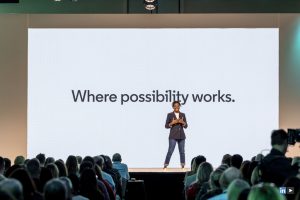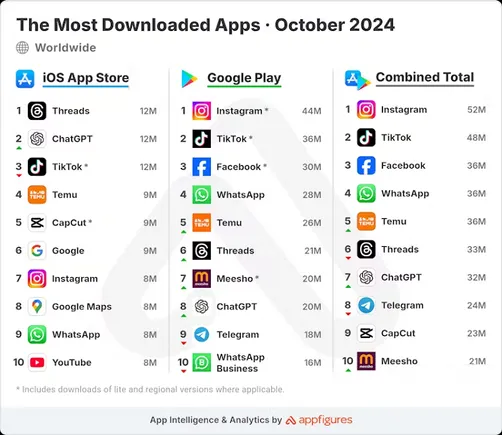Reading Time: 26 minutes
Are you feeling overwhelmed by the prospect of integrating AI into your business operations?
Do you struggle to determine if your organization is even ready for AI? Many businesses face these challenges, unsure how to navigate the complexities of AI readiness and maximize its potential for efficiency and growth.
The uncertainty and complexity can be frustrating, making it difficult to know where to start or how to proceed without wasting resources or missing out on opportunities. AI promises incredible benefits, but without a clear roadmap, it can seem like an insurmountable task.
That’s what Katie Robbert is here to help us with.
LISTEN TO AI IN MARKETING: UNPACKED:
WATCH AI IN MARKETING: UNPACKED:
Katie is the CEO and Co-Founder of Trust Insights, a renowned data science and analytics consulting firm. With extensive experience in business consulting, marketing consulting, and management consulting, Katie is a recognized authority on leveraging data and AI to drive business success. She frequently speaks and writes about generative AI, change management, and unstructured data analysis. Today, she will walk us through the 5P Framework, a practical approach to assessing AI readiness, and share how Trust Insights utilizes AI and automation to support their services.
AI in Marketing: Unpacked host Mike Allton asked Katie Robbert about:
✨ Understanding the 5P Framework: Learn about the 5P Framework and how it can be used to assess your organization’s readiness for AI integration.
✨ Practical Steps for AI Readiness: Discover practical steps businesses can take to prepare for AI integration using the 5P Framework.
✨ AI and Automation for Small Businesses: Gain insights into how small businesses can leverage AI and automation to enhance efficiency and productivity.
5P Framework
- Purpose
- People
- Process
- Platform
- Performance
Learn more about Katie Robbert
Resources & Brands mentioned in this episode
Full Transcript
(lightly edited)
AI Readiness: A Practical Guide Using the 5P Framework with Katie Robbert
[00:00:00] Katie Robbert: That’s really what it comes down to is you can use generative AI. I’m not saying don’t use it. I’m not saying shy away from it. What I’m saying is include people in the conversation of what that looks like, because a lot of people to your point, Mike, it’s just one more thing for them to do. You’re giving them the tools and they’re not using it because they haven’t gotten education.
They haven’t gotten training. They don’t know where in their process it fits. They don’t know if they start using it. Will they suddenly be out of a job? And so having that clear purpose upfront is going to get you farther to your goal, farther to the performance of, did we solve the problem?
[00:00:35] Mike Allton: Welcome to AI in Marketing: Unpacked, where we simplify AI for impactful marketing. I’m your host, Mike Allton here to guide you through the world of artificial intelligence and its transformative impact on marketing strategies. Each episode, we’ll break down AI concepts into manageable insights and explore practical applications that can supercharge your marketing efforts.
Whether you’re an experienced marketer just starting to explore the potential of AI, this podcast will equip you with the knowledge and tools you need to succeed. So tune in and let’s unlock the power of AI together.
Greetings program. Welcome back to AI in Marketing: Unpacked where I selfishly use this time to pick the brains of experts at keeping up with and integrating or layering artificial intelligence into social media, content, advertising, search, and other areas of digital marketing. And you get to learn to subscribe to be shown how to prepare yourself and your brand for this AI revolution and come out way ahead.
Now, are you feeling overwhelmed by the prospect of integrating AI into your business operations? Do you struggle to determine if your organization is even ready for AI? Many businesses face these challenges. They’re unsure how to navigate the complexities of AI readiness and maximize its potential for efficiency.
That uncertainty and complexity can be frustrating, making it difficult to know where to start or how to proceed without wasting resources or missing out on opportunities. AI promises incredible benefits, but without a clear roadmap, it can seem like maybe an insurmountable task. Well, that’s what Katie Robbert is here to talk with us about.
Katie is the CEO and the co founder of Trust Insights, a renowned data science and analytics consulting firm with extensive experience in business consulting, marketing consulting, and management consulting. Katie is a recognized authority on leveraging data and AI to drive business success. She frequently speaks and writes about generative AI, change management and unstructured data analysis. Today, she’s going to walk us through the five P framework, a practical approach to assessing AI readiness and share how trust insights utilizes AI automation to support their services. Hey, Katie, welcome to the show.
[00:02:43] Katie Robbert: Hey, Mike, thanks for having me today.[00:02:46] Mike Allton: So glad you’re here. Can you start by just telling us a bit about your background and the journey that’s led you to found Trust Insights and in AI in general, I always like to kind of prep my audience and, and have my guests share why they are where they are today, because a lot of us have been on different journeys.
Some of us like myself, frankly, have just recently started AI, but I know it’s been at the fore for you for much longer.
[00:03:13] Katie Robbert: Yeah. You know, it’s interesting. So I have a film degree. And so my film degree is essentially useless. I, once I got my film degree, so I got my film degree. So I live in New England and at the time the film industry hadn’t made its way over to the East coast.
Everything was still very much based in either New York or Los Angeles. And I couldn’t afford to move to either one. And so I had to find like a big girl job. And so I ended up getting a job. working on clinical trials for substance abuse medications, like opiate stimulants, those kinds of things. And I learned for about a decade how to run clinical trials, how to do survey development, but more importantly, the ins and outs of software development and data analytics, because I worked very closely with our data team, our epidemiologists, and I worked very closely with our development teams.
And so what that whole software development life cycle was. And then I also worked very closely with our sales and marketing teams. So while clinical trials was a good foundation, what it really gave me was exposure to a lot of the different disciplines within an organization, which is what I feel has made me really well rounded and, you know, gave me the ability to move on to the next thing.
So from there, I actually ended up at a PR agency of all places running the marketing technology team. And so that’s where what feels like just yesterday, but about 10 years ago, I started actually learning about digital marketing. And so terms like CPA and ROI and all of that were brand new to me.
I didn’t know what any of it meant. So I had to sort of learn on the fly as I was managing those digital teams. I knew nothing about advertising, affiliate marketing, you know I really didn’t know anything about PR either, but I was a really good people manager. And so that’s really what sort of carried me through to where I am today.
So about six years ago the agency that I was at decided to go in a different direction. They got bought out and I was ready for a change. I was ready to sort of do my own thing. And the person I was working with on the team Chris Penn was also ready for a change. So we decided that, you know what, between the two of us, I think we have enough skills to start a business.
He was very invested in everything, machine learning, artificial intelligence. He introduced predictive analytics to the team in 2018 and their minds were blown by it. And so I was like, you know what, I feel like he’s got something. I’m looking to sort of do more of the operational side of things. So let’s give it a go.
And six and a half years later, we’re still here. The team is still really small. We like it that way. We have, it’s myself and Chris, we have John Wall, who’s the head of our business development and Kelsey who are as account manager, everything else is automated and AI ified for lack of a better term.
[00:06:18] Mike Allton: Love it. You guys are doing fantastic work. We had Chris on an earlier episode. I’ll link to that in the show notes because that’s a cannot miss episode for sure. But today, you know, as I tease, we’re going to talk about your, your five P framework. And before you walk us through what that is, I’d love if you kind of kind of set the stage and explain why it exists today.
What inspired you to develop this framework, particularly for assessing AI readiness,
[00:06:46] Katie Robbert: digital transformation. I hate that term. I hate it with a fiery passion, not because it’s a useless exercise, but because, at least in my experience, it’s never done correctly because there’s so much emphasis on the technology.
So digital transformation is essentially the Act the effort of introducing technology into your existing organization. So it’s people process technology. The first problem I had with that was like, well, platform is right there. Alliteration marketers come on. And then I was like, come
[00:07:24] Mike Allton: on, I was like,[00:07:27] Katie Robbert: so the other problem with it is because you put technology first, there’s really no consideration or less of a consideration for the people who actually have to use the technology.
And me being a people manager, I’m always focused on the teams first. What do they need? How does it. you know, impact their day to day if we introduce something new into their process, because it can be very disruptive. And digital transformations, while good in theory, are very disruptive. And so I took that, I took a riff on digital transformation and created the 5P framework, which is people, process, and flat platform bookended by purpose And bookended by performance because the other challenge I saw with companies doing digital transformation is there wasn’t a clear goal other than, you know, we need to use this new technology, you know, we need to put everything in the cloud, everything needs to be big data.
Okay, but why? What does that mean? And so from there I’ve been working on it. I remember it was actually over probably the holiday break. somewhere around 2020 2021. And I started leaving, you know, scattered, you know, as I was falling asleep notes in our slack channels and Chris and John were like, Am I supposed to respond to this?
But it was just my brain sort of like picking apart like five P’s. What does that mean? There’s something here. And from there I’ve started developing it and building it out. And so the five P framework is a decision making tool for businesses. It helps you gather simple business requirements and it helps give you direction and keep you on course.
So it is purpose. People, process, platform, and performance. Purpose and performance are always on the bookends. People, process, and platform are interdependent on each other. And so you need to be able to acknowledge each of those pieces in order to have a fully comprehensive plan.
[00:09:35] Mike Allton: Okay, so first of all, I’m glad I didn’t start off by framing this as digital transformation because you would have lit me on fire, but I also got to forewarn you, I remember that’s a pet peeve of yours and I will probably bring it up the next time we meet just in casual conversation.
Hey, how’s that digital transformation going? And
[00:09:51] Katie Robbert: that’s fine. And I’ll flip the table that’s right next to you and be like, don’t you say that to me.[00:09:55] Mike Allton: That’s exactly right. But thanks for for spelling that out. That makes that makes complete sense. I particularly love the fact that you’re including performance in there because you’re right.
That is a key part that needs to be evaluated. You know how successful we’re being with whatever is that we’re trying to accomplish. Let’s apply that to a I integration. Walk us through how businesses are going to use your five P framework in that way.
[00:10:21] Katie Robbert: So I’ve talked with a lot of leadership teams that have said to me, we need to use AI.
I want to disrupt my business with AI. My teams need to be using AI. We need to save money with AI. And those are all really good starting places. And so the way that then I would use the 5P framework or the way that I have used the 5P framework with them is I always start with the purpose and I really try to break it down to what is the problem you’re trying to solve.
Forget about AI for a minute. Take the technology, take the platform out of your problem statement, and let’s just get into the deep dive of what is it that you’re trying to do. So a lot of times it’ll be the problem I’m trying to solve is I need to increase my profit margin from 17 percent to 23 percent so that I can be more attractive to investors or buyers, or I need to decrease my overhead.
Or I need to find efficiencies in my teams because they’re spending too much time doing certain tasks. And so when you take the platform out of the problem statement, you take away that bias that that particular technology is the only solution. And that’s where I see a lot of companies getting it wrong is they’re saying, I need to solve this problem with AI.
When it should really be, I need to solve this problem, period. And then when you start to go through people, who’s involved, both internally and externally, what does it mean for your customers? If you, you know, solve this problem, what does that look like for them? What does it mean for your team? You know, is it just your marketing team?
Well, does your marketing team give information to your sales team? Does your support team give information to your marketing team? Who are all the different players that are actually going to be touching this part? And that’s where you start to outline the process. Well, how does the task itself get done?
You know, if the problem you’re trying to solve is to find more, you know, efficiencies. Well, you have to outline each of the processes that you’re doing. That’s where companies get stuck because process documentation is something that’s often overlooked. It’s not done. It’s boring. I love it. But it’s boring for a lot of people because it’s not the instant gratification.
Well, let me just do something. Let me just push a button. Let me just thrust AI upon my team and have them do something. The way to approach it is to give, is to understand the current state. And that comes from talking to your people and understanding the process. Then. You can move on to, okay, is AI the solution, or is it just a matter of, we have the wrong tools, we should be using, you know, a social media scheduling tool versus a spreadsheet, for example, you know, that’s not necessarily a problem that AI is solving, that’s just, you know, having the wrong set of tools for the solution.
I actually work with a animal shelter and the executive director will come to me a lot of times and say, well, can AI do this? Can AI do that? And I have to slow her down. She’s very excited about it, but I have to kind of reel her back in. And. ask her, well, what is the problem that you’re trying to solve that you feel like AI is the solution for?
And so far, everything she’s been asking, AI has not been the solution. And so we’ve walked through what is the problem you’re trying to solve? Who are the people involved? What is the process you’re currently doing now? What are the platforms that you have that you’re using that aren’t working? And then you work on the performance.
Did you answer the question? Did you solve the problem? And that to me is one of the most important piece because with digital transformations, I’ve seen again, and I’ve experienced them. There’s no real end. It’s just, there’s no closure. It’s just like, okay, we did the thing, but like, how do you know you did it?
Well, how do you know you completed it? How do you know you made things better or worse?
[00:14:19] Mike Allton: What does success look like? Right? That’s, that’s the question. I love it. I love, I love this perspective because it’s, it’s the classic issue of, you know, to the hammer, everything looks like a nail. That doesn’t mean it’s the right tool for that application.
I love that approach. Could you walk us through how and specifically a client that you you’ve worked them through this process and maybe some of the results that you and the client have seen?
[00:14:44] Katie Robbert: Yeah, absolutely. So I’m currently working with a client who came to me and said, we want to disrupt our whole organization with AI.
And I was like, okay, that sounds like fun. I love disruption, but I also like process and order. So I’m a little bit of a killjoy in that respect. So what, so knowing that they wanted to disrupt their organization, I was able to use the 5P framework to really dig into what that meant. And so a lot of the problem statements that I’ve been echoing here.
So increasing profit margins, finding efficiencies, one of the problems they wanted to solve was to be able to find efficiencies in the work so that they could pay their team members more and like increase their livable wages, which I was like, that’s a great problem to solve. Let’s absolutely find solutions to that problem.
And so now we are in the phase of the project where we’ve talked to the people, we’ve gotten all of their feedback on their processes, and now the next step is to outline a roadmap and say, these are the things that you’ve outlined. You’ve prioritized the things that are repeatable, you’ve prioritized the things that are high value, low value, you like doing, you don’t like doing, take a lot of time.
You know, whatever the situation is. And so now we’ll be putting together a roadmap of where generative AI can fit into these processes and an education plan for them to start to, you know, get up to speed. And then the step after that is that we will be measuring performance because we’ve collected all of that data upfront.
We can say, did this task get more efficient? Did we cut down on the time? Is it still giving high value? to the clients or did we decrease the value by introducing AI so we can start to adjust the approach that way but without doing all of that upfront work and just indulging them and saying I just want to disrupt with AI and just throwing AI at it we’ll have no idea whether or not we’ve done our jobs.
And it’s just, it’s not a scalable and repeatable approach to just start using it. It’s good to experiment. I’m not discouraging people from experimenting with AI, but to fully integrate it into an organization is a culture shift and culture starts with the people.
[00:17:02] Mike Allton: That makes a ton of sense. Are there situations or kinds of clients that have approached you and you’re like, this is not a good fit for you.
Not a good time. I don’t mean just budget, you know, but is there a situation where this is not a good idea?
[00:17:20] Katie Robbert: I have a couple of clients that are very stubborn that really just say like, great, but like we have, I want to, I need innovation awards. I need to be using AI, like what, just AI everything. And so that’s why I sort of say like, I’m sort of like the killjoy because I can get you there. I can get you to using it.
But I’ve also been doing it long enough to know that you can’t just give someone a new tool and say, use it and make it great. There has to be consideration for the people involved. And again, that sort of goes back to my whole criticism of the way that digital transformation is traditionally represented is that it’s platform first.
people last. The thing that, the, the change that I want to make with my, the Trust Insights 5P framework is that it puts people right up at the front along with what is the problem you’re trying to solve.
[00:18:14] Mike Allton: Yeah, I love that approach. And in fact, we’re seeing the ramifications of people who aren’t doing that in the news with these mass rollouts of like Microsoft copilot or other kinds of paid tools where companies are spending a ton of money to just give all their employees the tool, which sounds nice.
It sounds empowering, but if it doesn’t have the training, if it doesn’t have the purpose and they’re not talking about what success looks like, they’re realizing really quickly that, wow, most people aren’t using these tools and the people who are, Oh, Gee, they saw 11 percent reduction in email time spent cares, you know, how is it really having an impact on the company?
So this is a fantastic approach folks. We’re talking with Katie Robbert about the importance of having a structured approach to assessing and implementing AI throughout your organization. And how to get started. And we’re going to talk about some of the potential pitfalls and the challenges next. But before we do, a quick message from my favorite AI tool.
This episode of AI in Marketing: Unpacked is brought to you by Magai, your gateway to making generative AI incredibly simple and accessible. Wondering how to Seamlessly integrate AI into your marketing strategy without getting bogged down by complexities. That’s exactly where Magai shines. It provides user friendly AI solutions that empower marketers just like you to innovate and elevate your campaigns without needing a degree in science.
Imagine having the power to generate creative content, insightful marketing data analysis, or even personalized customer communications. All at the touch of a button. Magai isn’t just about providing tools. It’s about. transforming your approach to marketing with AI that’s tailor made to be straightforward and effective.
So whether you’re looking to boost your content creation process or want deeper insights into your marketing performance, Magai makes it all possible with a few clicks, no fuss, no hassle, just results. Ready to simplify your AI journey? Visit Magai today to learn how their solutions can revolutionize the way you engage with your audience.
with your audience. Don’t just market, market smarter with Magai. Tap the link in the show notes. So for those businesses that do fit the criteria and they’re able to proceed, what are some of the challenges or potential pitfalls they might see when they’re starting to integrate AI and they’re working through the 5P framework?
[00:20:33] Katie Robbert: The biggest challenge is not the tools themselves, it’s resistance from the teams. And so that’s where really having a clear purpose is. part of the key to success. And so, you know, we as humans, we naturally want to know like, why, why are you asking me to do this? Why am I being tasked with this extra stuff?
Where does it benefit me? And so by starting with, this is the problem we’re trying to solve being very transparent. You know, we’re trying to increase our profit margins from this to this. This is why we’re doing it, not just because we think it’s cool or because everybody else is doing it. That’s not enough.
Reason for your team. to feel like they can get on board and have a sense of ownership. So I’m going through, I actually just ran in conjunction with doing the 5P framework with one of my clients, I ran an AI sentiment survey. And so this was a survey that I sent internally to their team to just understand how people were feeling about it.
And if they had confidence in the leadership team to navigate all of the changes that AI is going to bring if they felt like their jobs were secure if they introduced AI. So understanding how your team is feeling about the use of a new technology like generative AI is really important before introducing it.
You know, to your point, you were saying we’re seeing the you know, ripple effect of these companies that are just doing these big rollouts like Microsoft copilot. Another really good example that isn’t an AI example is the way that Google handled the transfer from Google Analytics 3 to Google Analytics 4.
Nobody asked for Google Analytics 4. Nobody asked for everything to be changed. And so they did it, you know, this is my own personal opinion. They did it without the end user in mind, without the people. involved in the process to say, this is what we actually need. And now, I mean, I’ve lost count of how many people who’ve said they’ve basically abandoned their web analytics because they can’t use it.
They don’t trust it. It’s too clunky. It’s too cumbersome. Like it’s just, it used to be an integral part of their day to day and their decision making. And now they’re just like, Well, whatever. YOLO. We’re going to figure it out. And I don’t want to see people make the same mistakes with generative AI because they’re not including their teams in the conversation.
That’s really what it comes down to is you can use generative AI. I’m not saying don’t use it. I’m not saying shy away from it. What I’m saying is include people in the conversation of what that looks like because a lot of people to your point, Mike, it’s just one more thing for them to do. You’re giving them the tools and they’re not using it because they haven’t gotten education.
They haven’t gotten training. They don’t know where in their process it fits. They don’t know if they start using it, will they suddenly be out of a job? And so having that clear purpose up front. is going to get you farther to your goal farther to the performance of did we solve the problem?
[00:23:37] Mike Allton: That makes a ton of sense.
And I’m laughing about the GA analogy, because because I’m right there with you. I’ve been a web developer for over a decade. And still, when I went and looked at the new Google Analytics, it boggled my mind. I’m like, I don’t and I don’t want to have to pay for a course just to figure out how to use Google Analytics.
This tracking tool I’m talking about for my own site at this point where I just really want to see how the traffic is doing day over day or any articles trending up that sort of thing. So now I just use jetpack stats in the WordPress environment because it literally tells me everything I need. In fact, it’s actually better because it tells me today how I’m doing.
Whereas the new Google analytics won’t tell me up until, you know, it only says how you did up until yesterday. So. That makes a lot of sense. I want to actually go back to something you said earlier about Trust Insights and how when you were talking about your role there today and how the firm is organized, you said you’ve AI’d everything and a lot of it’s automated because you’re a small team, which is terrific.
Talk to me about the role then that AI and automation specifically plays in the services that you’re offering today.
[00:24:43] Katie Robbert: So we had to do a lot of what I’m talking about with our clients. So before we could get to the point where we could. AI or automate a lot of stuff, we still had to create those standard operating procedures.
And so we had, you know, I took a lot of time to document a lot of what we’re doing so that we could introduce AI so that we could get to doing really cool stuff with our clients. And one of the things that we’ve started doing is ideal customer profiles. And so it’s, Something that, you know, a lot of companies are maybe spinning up startups to do just that.
But essentially what it is, is using your data to understand your customers. And it’s sort of new tech solving old problems. We’ve always needed to understand who our customers were. We’ve always needed to understand what their pain points were. But now the way that at least we’re using it at Trust Insights is that with a very small sample of your data, and our system instructions on our side and supplemental information from us, we can actually put together a comprehensive, here’s the firmographics, here’s the demographics, here’s their pain points, here’s how they make decisions, but also here’s an action plan based on the marketing that you’re currently doing, based on your channels of where you could be reaching these people.
And so I’m a firm believer in. Data for data’s sake is just sort of like a waste of time. I always want to know the, so what, and I’ve asked that question so many times that we actually called our live stream. So what, because I just, it, it, it makes me crazy to be given a pile of information that I can’t do anything with.
And I wanted to be able to create an ideal customer profile that you wouldn’t have to say. So what? Or you would create it and then it would just sit on a shelf and you never use it. And so, you know, I feel like because we’ve done so much with AI and automation internal to the company. We’ve really honed our skills to figure out where is it appropriate to use AI partnered and supported by that human intervention.
And so we can use generative AI to build the ICP, but then the human generally me goes through and says, does this make sense? Is this usable information? Can somebody then take this report and go, okay, I now have a plan. I can do that thing. And I feel like that’s one of the. Big differentiators of the work that we do as consultants is, unless there’s a really good reason, I’m never going to leave you without a so what of your data and your analysis.
[00:27:23] Mike Allton: That is a huge differentiator. It’s a terrific example, in fact, of how You’ve got a business that’s actually believing and using and honing their craft on themselves first. And then they’re rolling that out to their clients. And that’s what makes you guys, you know, one of the top consultancies and experts in this space, you just, you’re living it you’re doing it for yourself, which is unfortunately a bit of a contrast from many, many other people, whether we’re talking about AR, social media, or, you know, whatever other discipline we’re talking about within marketing, but we were also talking about.
You know, we talked about these huge Microsoft go buy it rollouts. We were talking about like giant enterprise firms like Moderna and so on. Contrast with, with your, as you said, a small team. How does that smallness influence how you’re approaching AI on automation? And are there any particular strategies that you found effective?
[00:28:15] Katie Robbert: I like to believe that we can, you know, go deeper. We can sort of like really focus on the relationship building. And so this is sort of the. The piece that we don’t want to automate with AI is that human to human interaction. And so, you know, I’m, you know, I’m not against using big firms, but you tend to get less personalization with it.
And companies that are looking to integrate artificial intelligence, it because it’s a culture shift, because it’s about your people. I’ve worked with those larger firms before on the other side of being the person sort of on the receiving end working the team and it’s just very cold and okay great here’s the scope of our engagement we’re going to do the thing good luck bye and they sort of leave whereas I feel like because we keep our team small and because we you know don’t take on hundreds of engagements at a time and have a stable of contractors who are just sort of like executing and checking the boxes we can really get to know.
The teams that we’re working with, the clients that we’re working with, and really understand what their pain points are, what is keeping them up at night, what their concerns are about AI, and then we can, you know, I have a client that I’m working with now who engaged us to build personas he works in the healthcare field, and once we got into the contract, and when we started talking about it, He was like, you know, I don’t know if this is maybe the best idea because of the field he’s in.
There’s a lot of risk involved in the healthcare field, especially when you start automating things that patients are going to interact with. And so we talked it through and we agreed, you know what, maybe that’s not the best use of our collective time together. But here’s a list of everything else that we can do to bring you closer to that goal.
And so I feel like because we’re a small firm, we have the ability to be more agile, to pivot. We’re not locked into these, you know, big, cumbersome contracts that if you want to do something different, you have to have change orders and addendums and more signatures and go through legal. I’m the person you have to go through, and I like to consider myself as pretty reasonable.
Mostly, sometimes,
[00:30:24] Mike Allton: mostly, sometimes no, that focus on relationships and agility is terrific. And I asked that question to tee up the next one, because as a small business, you can relate to other small businesses, even though you’re near knowledge of AI. And automation is vastly superior for other small businesses who aren’t as experienced.
Right. Help them understand how utilizing AI is really going to help them in terms of efficiency and productivity.
[00:30:54] Katie Robbert: One of the things that I hear a lot is that, you know, well, I don’t have time to use AI. I have so many other things going on. And that’s true. Like I am also someone who’s like, I don’t have time to do it.
Because I have like a million other things in my place. I’m a small business. It’s just me doing, you know, the role of 10 people. What I’ve started to do is just pick and choose my moments where I’m like, let me see if AI can help me here. And I think it was, I mean, literally just as late as yesterday, the majority of my day, I was using generative AI for a lot of the things I was doing because I had to build that comfort level with it.
I don’t consider myself a power user of generative AI. I feel like I’m more representative of where a lot of marketers are is I’m still kind of skeptical. I’m still wanting to have control over a lot of the things that I’m doing and producing, but I’m finding those moments where AI can be helpful. So we actually built, and it kind of cracks me up, we built KatieGPT.
And so KatieGPT is built on all of my writing, my instruction, my tone, And so when I interact with Katie GPT, I’m basically mirroring myself. And so at the very least, if I’m writing a blog or a newsletter, I can get an outline based on what I would have written anyway. And it saves me, you know, a good chunk of time of sitting at like, you know, a blank screen going, what am I going to write about this week?
In conjunction with, you know, I mentioned that we’ve started building out ideal customer profiles because we built out. The trusted sites, ideal customer profile and put that as a set of system instructions into a large language model. I can then take the outline that Katie GPT has given me, give it to our ideal customer profile and say, does this resonate with our audience?
Are they going to like it? What should I do instead? What’s going to make it even more valuable to our ideal customer profile. And I, that can all happen within a span of about 10 minutes. And I can say, okay, I’m writing the right kind of content or I’m writing the wrong kind of content and here’s how to change it.
And that saves me a lot of research time of wait, where’s our keyword list and what have I already done? And you know, what are they talking about this week? And so it just, it expedites. a lot of the brainstorming process. And then I still, you know, I could use more AI to write it, but I still want to be the person writing it.
But I’m finding those moments where if I inject enough of my own knowledge into the AI, the AI can be a supporting role to me.
[00:33:34] Mike Allton: I hope all of you listening are resonating with what Katie’s saying, because it’s the approach we’ve been talking about for almost all of our previous episodes, right? Start small, start with a few things, start with, you know, how can AI help me with one specific task?
Be a little bit more efficient, work with the AI, do the pre work that you need to train the AI to understand who you are, what your business is, what your tone and your voice, depending on how you’re applying it and just slowly, gradually. Start to build that trust and that understanding at the same time.
So I appreciate you kind of outlining exactly how you come to those same conclusions. Now let’s look ahead. What kinds of trends are you seeing when it comes to AI and automation? And I understand it’s a really challenging question to answer because things are changing so rapidly. But I’d still love your take on what you see happening.
And more importantly, how can businesses kind of prepare to leverage whatever it is that you think is coming next?
[00:34:27] Katie Robbert: In terms of things that are coming, I think really the sky’s the limit. I think that you’re going to see a lot more startups that are, you know, Trying to focus down on one specific task and really nailing it.
I mean, if, if, if a startup is going to, you know, build PowerPoint presentations for me, please give me a call because that’s sort of one thing that’s missing from the market is AI that does really good presentations, like. From an outline. So that’s something I’m going to just sort of manifest as a trend.
But in terms of real true trends, I think that, you know, AI is only going to get better at replicating the work that we’re doing provided we can guide it in the right direction. So what I mean by that is so I just mentioned we built Katie GPT. Well, we built KatieGPTS six months ago, and so that particular large language model has already fallen behind where technology has evolved, and so we need to update her.
We need to include new information. We need to update the models so that It’ll become hard to, to distinguish between, are you talking with Katie in real life or are you talking with Katie GPT? So I feel like the technology is going to evolve to such a place that if you do it correctly, and that’s the big caveat, if you do it correctly, it will be harder to tell the difference between the person and the machine.
We see right now that, you know, LinkedIn, for example, has rolled out the ability to use AI to respond in comments and. It’s a very simplistic way of looking at it. And unfortunately, because it’s so simplistic, the responses that people are giving are so poorly written and so, you know, unvaluable that you can tell immediately, well, AI wrote that and that’s just kind of lazy.
You couldn’t string together two sentences and I’m not calling out anyone specifically. I think it’s good to experiment with it, but you need to really hone it. It’s, It’s very much the, if you don’t give it more knowledge, it’s just going to stay very flat and you’re going to plateau with it very quickly.
[00:36:28] Mike Allton: Yeah. That’s a use case that I questioned from the very start. I mean, what’s, what’s the point of giving a viewer of a post a generic comment to add to that post? What value will they bring? If, if you want to do help them, it’d have to be a comment that’s personalized. To Katie Robbert on my post, what would Katie say on my post?
Well, then you’re going to be helping us. But how are you going to do that with an AI? I don’t know that I want LinkedIn’s AI to know that much about me. I don’t know. There’s, there’s, there’s questions and concerns there, but the way it’s rolled out now, you’re right. It’s, it’s. Pretty useless, but things are changing.
Things are improving all the time. It’s exciting. In fact, how fast things are moving in this industry. If you’re in it, like, like you and I are Katie, this has been absolutely fantastic. Thank you so much. Such a jam packed episode so much. I know people are going to want to go back and listen to this a couple of times, but for those who have more questions who want to reach out, where can they go to find you?
[00:37:23] Katie Robbert: You can generally find me on LinkedIn at Katie Robbert. You can find me hanging around at trust insights. That’s trust insights. ai and you can join our free Slack community analytics for marketers, which is trust insights. ai slash analytics for marketers. I ask questions of the day every single day.
Or weekdays, I should say. And on Fridays non work related questions that get a little unhinged. So you can come join the party.
[00:37:49] Mike Allton: Fantastic. Thank you so much, folks. Thank you for listening. We’ll have all the links to everything Katie talked about today in the show notes. That’s all the time we’ve got for today, but don’t forget to find the AI Marketing Unpacked podcast on Apple and leave us a review.
We’d love to know what you think until next time. Welcome. Thanks for joining us on AI in Marketing: Unpacked. I hope today’s episode has inspired you and given you actionable insights to integrate AI into your marketing strategies. If you enjoyed the show, please subscribe on your favorite podcast platform and consider leaving a like.
We’d love to hear your thoughts and answer any questions you might have. Don’t forget to join us next time as we continue to simplify AI and help you make a real impact in your marketing efforts until then keep innovating and see just how far AI can take your marketing. Thank you for listening and have a fantastic day.

Related
Discover more from The Social Media Hat
Subscribe to get the latest posts sent to your email.










